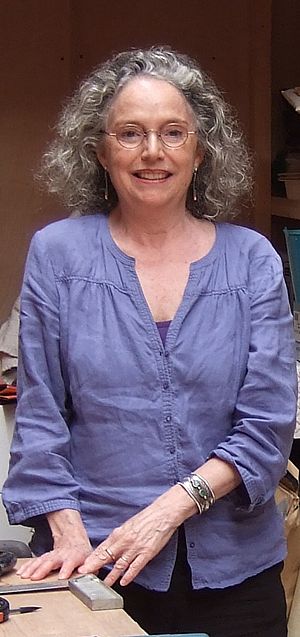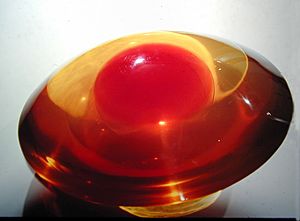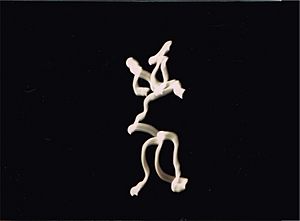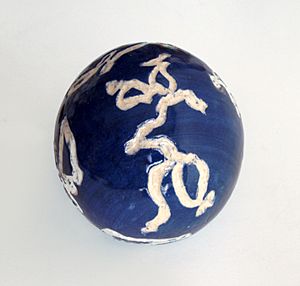Sara Holt facts for kids
Quick facts for kids
Sara Holt
|
|
|---|---|

Sara Holt in her studio, Paris, 2014
|
|
| Born | March 14, 1946 Los Angeles, California
|
| Nationality | American |
| Known for | Sculpture, photography, ceramics |
Sara Holt, born in 1946, is an American artist. She creates amazing art using sculpture, photography, and more recently, ceramics. Her work is special because it mixes ideas from both science and art. She is known for exploring how these two fields can come together in creative ways.
Contents
Sara Holt's Artistic Journey
Sara Holt finished her art degree from the University of Colorado in 1968. After graduating, she traveled in Europe. She loved France so much that she decided to stay. From 1969 to 1971, she was an artist living and working at the Cité internationale des arts in Paris. She has lived and worked in Paris ever since.
Her childhood home, designed by architect Irving Gill, and her family's interest in science and art, greatly influenced her work. Sara loved to experiment with new art techniques. She combined the natural qualities of materials, like how resin casts, how ceramics are glazed, or how photos are developed. She also carefully planned her art pieces.
The exciting 1960s gave her the freedom to explore. She mixed different interests that seemed opposite. For example, she used light and clear materials in her resin sculptures. But she also took photos in the dark. She even let chance play a part in her art. Sara Holt's art explores important parts of nature, like light, color, earth, space, and time. Her work is also spiritual and poetic, making it a unique blend of science and art.
In 1968, she met artist Piotr Kowalski. The next year, she got a studio in Paris. There, she kept working with resin and met many other artists and critics. Her first big art show was in 1971 at l'ARC in Paris. This was a very important place for modern art. Her exhibition included colorful resin sculptures like "Little Rainbow Snakes," a large cone, big spheres, and tear-shaped prisms.
What Sara Holt Creates
Sculptures and Materials
Sara Holt has worked with many materials, including bronze, plaster, ceramics, and wool. But she mostly uses resin. She discovered resin in college and loved how it let light shine through. A trip to the Grand Canyon in 1968 inspired her early interest in layers and natural processes.
She makes her resin sculptures by pouring different colored layers into molds. Each layer needs time to set. Some of her pieces can take up to a year to finish!
Since 1972, Sara has created very large sculptures for public spaces. Her first big public artwork was "Douze Cones" in Bagnolet, France. In 1977, she spent a year in the USA working on "Double Rainbow." This outdoor sculpture was made of welded and painted steel. She kept exploring how colors and light affect space. In 1981, she met Jean-Max Albert, and they worked together on many public art projects.
A major step in her work was "Light Tubes" in 1984. This art installation used light and color throughout a space. She spray-painted Plexiglas tubes with different shades and patterns. Then, she put neon or fluorescent lights inside. These tubes could hang on a wall or stand upright. "Light Tubes" brought together her ideas about light, color, and patterns.
Photography and the Sky
In 1969, Sara started taking photos of her clear sculptures. This led her to new experiments. She began photographing the night sky. She captured the movement of stars, creating colorful curved lines of different lengths. For her "Star Crossings" photos, she took two long exposures of the sky. She moved the camera between exposures to create unique patterns. These photos are both artistic and scientific.
Using a sailboat as a "writing tool," Sara took long exposure photos of the moon. The rocking of the waves created special signs or "messages" in her images. She has collected a whole alphabet of these images, including pieces called Papillon, Why, and No.
Ceramics and Nature's Messages
Since 1993, Sara Holt has been working with ceramics. She paints some of the signs from her moon photographs onto her ceramic pieces. She also creates natural-looking ceramic "Oysters." Working with clay and its organic feel helps her connect with nature. When she photographed at San Miguel Island, she learned about an Indian belief. It's about giving back to nature and the universe what you have received. For Sara, this means sharing the "messages" she found while photographing the moon from her rocking sailboat at night.
Exhibitions and Public Art
Solo Exhibitions
Sara Holt has had many solo art shows where only her work is displayed. Some of these include:
- Sara Holt, Sculptures, ARC, Musée d'Art Moderne de la Ville de Paris, 1971
- Städtische Kunstsammlungen, Ludwigshafen, Germany, 1972
- Galerie Lucien Durand, Paris, 1973
- Night Light, Ufficio dell'Arte, Paris, 1979
- Why, Galerie Vivian Veteau, Paris, 1981
- AcApA, Hôtel St. Simon, Angoulême, France, 1983
- Galerie Q, Tokyo, Japan, 1983
- Lumen, Hospice St. Charles, Rosny sur Seine, France, 1984
- Cathédrale Notre-Dame de Laon, L'Été de la Photographie, Laon, France, 1992
- La Box, Bourges, France, 1992
- L'Artothèque d'Entreprise Michel Ferrier, Grenoble, France, 1993
- Light Waves, Fleeting White Space, Anvers, Belgium, 1994
- Bassin d'essais des carènes, DCN, Val de Reuil, France, 1994
- Volume et Espace – Sara Holt, Institut Cochin de Génétique Moléculaire, Paris, 1995
- Sara Holt, Artothèque d'Angers, Angers, France, 2003
- Galerie Edouard Edwards, Paris, 2010
- October 2018, Sara Holt and Jean-Max Albert, Galerie Mercier & Associés, Paris, 2018
Public Artworks You Can See
Sara Holt has also created many public art pieces that people can enjoy in different cities:
- Douze Cônes, Bagnolet, France, 1972
- Arc-en-ciel, Sens, France, 1976
- Cônes lever et coucher du soleil, Joigny, France, 1977
- Double Rainbow, Pasadena, California, 1977
- Solaris, Chevigny-St. Sauveur, France, 1979
- Arc-en-ciel éclaté, Jardin des Plantes, Caen, France, 1982
- Quatre plafonds, Nice-Étoile, Nice, France, 1982
- Light Ray, Lieusaint, France, 1987
- La chambre de la lune, Centre National des Arts Plastiques, Château d'Oiron, France, 1993
- Auriga, (with Jean-Max Albert), Angers, France, 1995
Art in Collections
Sara Holt's art is part of many important public collections, meaning museums and art institutions own her work:
- Städtische Kunstsammlungen, Ludwigshafen, Germany, 1972
- Fond Régional d'Art Contemporain de Basse-Normandie, 1977
- Musée d'Art Moderne de la Ville de Paris, 1980
- Fond National d'Art Contemporain, Paris, 1983
- FRAC de Poitou-Charente, 1984
- Artothèque d'Angers, 1985
- Centre National d'Arts Plastiques, Château d'Oiron, 1993






